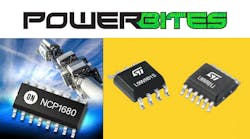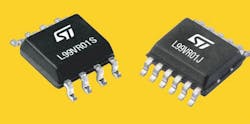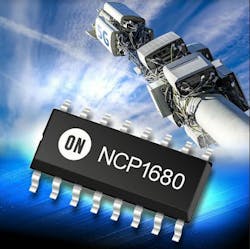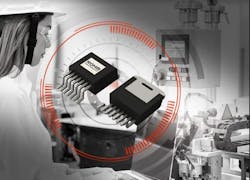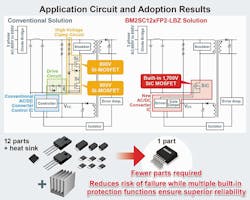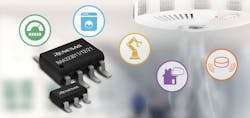This Week in PowerBites: Reimagined Regulators, Clever Controllers
This article is part of the Power Management Series: This Week in PowerBites
Automotive-Grade LDOs Include Diagnostics for Functional Safety
Equipped with eight selectable fixed-output voltages, diagnostic features for functional safety, and high thermal performance, STMicroelectronics’ L99VR01 AEC-Q100 qualified low-dropout linear voltage regulators help simplify system design and ease inventory management for automotive applications. They can supply up to 200 mA for powering loads such as body modules, junction boxes, instrument clusters, sunroof controllers, keyless-entry controllers, and sensors.
The regulators’ output voltage can be set to 0.8, 1.2, 1.5, 1.8, 2.5, 2.8, 3.3, or 5 V with an external voltage divider using three external selection pins. All output voltages are within ±2% of their nominal value, significantly more accurate than what's possible with an external voltage divider.
Although the regulators are available in two variants with different feature sets and packaging, both products offer a wide input-voltage range, from 2.15 to 28 V, and inputs that are tolerant to voltages up to 40 V, enabling them to withstand load dump. Thus, they can be used in applications connected directly to the battery voltage (VBAT) or for post-regulation to convert an already regulated voltage.
- The L99VR01S comes in a standard SO-8 package with Enable and Reset pins as well as safety features such as fast output discharge, undervoltage lockout (UVLO), thermal shutdown, and short-circuit protection. The quiescent current is reduced to 1 μA when disabled and the regulator operates from −40 to 150°C.
- The L99VR01J, available in a PowerSSO-12 package, has all of the features of the ‘R01S, but offers additional protection that includes a programmable short-circuit current limit, a thermal-limit warning, and an output-overvoltage status indicator. The ‘R01J also includes a programmable watchdog circuit that checks for correct operation of the host microcontroller. In addition, the L99VR01J has a wider operating junction temperature range (−40 to 175°C).
By integrating output-overvoltage monitoring, the new regulators can provide constant load protection. The diagnostic features ease the design of functional-safety-related applications, helping users achieve the required ISO 26262 ASIL value.
Both variants are in production now. Pricing for orders of 1,000 pieces starts from $0.28 for the L99VR01S and from $0.35 for the L99VR01J. Visit www.st.com/lin-volt-reg-l99vr01 for more information.
Critical-Conduction-Mode PFC Controller Offers High Efficiency, Low Cost for Offline Apps
ON Semiconductor’s NCP1680 critical-conduction-mode (CrM) power-factor-correction (PFC) controller IC is designed to drive a bridgeless totem-pole topology. The architecture consists of a fast switching leg driven at the pulse-width-modulated (PWM) switching frequency and a second leg that operates at the ac line frequency. This topology eliminates the diode bridge present at the input of a conventional PFC circuit, significantly improving power-stage efficiency.
The controller was developed specifically for ultra-high-density offline power supplies that operate with universal mains (90 to 265 V ac) at power levels of up to 350 W. The NCP1680 can be used with nearly any switching device, from conventional superjunction silicon MOSFETs to wide-bandgap devices based on silicon carbide (SiC) or gallium nitride (GaN).
The controller's architecture eliminates the rectifier bridge diodes, which account for approximately 4 W of losses in conventional PFC circuits used in a 240-W power supply (i.e., roughly 20% of total losses). Instead, the controller is based on a “totem-pole” configuration that replaces the diode bridge with switches and pulls in the boost PFC function to significantly improve overall efficiency. The new NCP1680 CrM totem-pole PFC controller accomplishes this by employing a novel current-limiting architecture and line-phase detection mechanism, along with proven control algorithms.
At the heart of this IC is an internally compensated digital loop control that supports a constant-on-time CrM architecture with valley switching. It also integrates a selectable discontinuous conduction mode (DCM) with valley synchronized turn that’s active during frequency foldback operation, enabling it to meet modern efficiency standards that require high efficiency at light load. The NCP1680's high efficiency and flexibility makes it a good choice for power-supply designs used in telecom 5G, industrial, and high-performance computing that operate with universal mains at recommended power levels up to 350 W.
With 230-V ac mains input, PFC circuits based on the NCP1680 could achieve close to 99% efficiency at 300 W. Just a few simple components are required externally to realize a fully featured totem-pole PFC, thereby saving space and component cost. To further reduce component count, the cycle-by-cycle current limit doesn’t require a Hall-effect sensor. Housed in a tiny SOIC-16 package, the NCP1680 also is available as part of an evaluation platform that allows for rapid development and debugging of advanced totem-pole PFC designs.
The NCP1680AAD1R2G (25-130 kHz) and NCP1680ABD1R2G (25-275 kHz) are available now, priced at $1.9066 each in quantities of 2,500.
Click here to download a product overview, and click here to request a full datasheet.
100-W DC-DC Converter Delivers Extreme Efficiency, Power Density for USB-PD Apps
Extending its CO2 Smart Power family of wide-voltage, high-frequency, point-of-load converters, Silanna Semiconductor’s new 100-W device targets USB-PD applications. The SZDL3105B fully integrated dc-dc converter (buck regulator), with its 667-kHz switching speed, can supply up to 5 A and 100 W of output power. It accommodates a wide range of input and output ranges that support input voltages of up to 27 V dc. And, like the rest of its CO2 product series, the new converter combines extremely high power density and efficiency with significant bill-of-materials (BOM) savings over other solutions.
During my conversation with Tim Wilhelm, Silanna's Director of Marketing, he said that some of these advantages arise from the converter's unique architecture that, among other things, reduces external components, and allows it to operate at a higher switching frequency. Thanks to the higher frequency, it’s possible to use significantly smaller external inductors and a smaller, lower-cost, higher-performing output filter.
Wilhelm also explained that, while some additional improvements in efficiency may have been possible with the use of WBG materials, such as GaN, those processes wouldn't have been able to support the high levels of integration that made it possible to dramatically reduce the size of the USB-PD adapters and other end products possible.
The converter's ability to operate at, or above, 94% efficiency across its normal output range also contributes to space savings—it eliminates the need for any heat sinking other than what can be obtained from the PCB its mounted on. As a result, Silanna says its customers are reporting increases in power density with volumes approaching 12% of that required by low-frequency competitive solutions.
The SZDL3105B's unique architecture gives designers flexibility to create USB-PD products that address their customers' specific requirements. This includes internal and external feedback resistor dividers that facilitate custom designs, and a momentary internal feedback path that enables clean and well-controlled startup operation until external USB port controllers can power up and take over control of the output voltage.
In addition, due to its extremely low no-load power consumption, designers can create a single product that meets or exceeds the eco-label certification requirements currently in place in Europe, China, the U.S., and other nations. Despite its high level of integration, the ‘3105B is small enough to be housed in a compact 4- × 4-mm QFN package.
SZDL3105B key features
- Optimal for USB-PD and fast-charging USB ports
- Up to 100-W USB-PD ports
- 667-kHz switching frequency for compact designs
- 3.3- to 21-V output at 5 A (covers USB-PD 3.0 and PPS applications)
- 7- to 27-V input
- Dual-input LDOs (VIN and VOUT) for product bias to optimize overall efficiency
- Space-saving 4- × 4-mm QFN package
- CO2 Smart Power
Applications
- USB-PD and fast-charging power adapters
- High-power-density dc-dc power supplies
- High-efficiency power adapters
- Battery chargers for mobile devices
Availability
SZDL3105B devices are currently being sampled to key accounts and will be in general distribution in the second half of 2021. More information is available at https://www.powerdensity.com or by contacting [email protected].
Offline Switcher Brings Lossless Zero-Cross Detection and X-Capacitor Discharge to Smart-Home Apps
Power Integrations says its LinkSwitch-TNZ switching power-supply IC is a more compact, energy-efficient, and lower-cost alternative to the discrete circuits typically used to detect the ac line zero-crossing in products such as light switches, dimmers, sensors, and plugs, or motor controllers for appliances. It combines offline power conversion, lossless zero-cross detection and, optionally, X-capacitor discharge functions in a compact SO-8C package. The high-efficiency LinkSwitch-TNZ IC can be used for non-isolated buck and buck-boost power supplies with up to 575-mA output current and provides up to 12-W output for universal-input isolated flyback designs.
Adnaan Lokhandwala, product marketing manager at Power Integrations, said, “The new LinkSwitch-TNZ ICs provide an accurate signal indicating that the sinusoidal ac line is at zero volts. This signal is used by smart-home and building-automation (HBA) products and appliances to control the switching of relays, IGBTs, and TRIACs to minimize switching stress and system inrush current. LinkSwitch-TNZ’s detection of the zero-cross point consumes less than 5 mW, allowing systems to reduce standby power losses versus alternative approaches that require 10 or more discrete components and burn 50 to 100 mW of continuous power.”
By providing power with ±3% regulation across line and load, and no-load consumption of less than 30 mW, the controller is able to deliver standby power to many more system features. It meets Energy Star's version 1.1 for Smart Home Energy Management Systems (SHEMS), and China’s GB24849. LinkSwitch-TNZ ICs also reduce component count by 40% or more when compared to discrete designs.
Optionally, an X-capacitor discharge function can be included in the package for high power applications, leading to greater PCB space reduction, low BOM count, and increased reliability (LNK331x).
Pricing & Resources
The LinkSwitch-TNZ switching power-supply ICs are priced at $ 0.84 in volume for 1,000 units. Four reference design examples are available for download:
DER-874 and RDR-866 are non-isolated buck designs delivering 6-V/80-mA output and 5-V/500-mA output respectively.
RDR-877 describes a 12-V/0.5-A output isolated flyback with secondary-side ZCD signal.
DER-879 describes a 12-V/0.75-A and 5-V/0.2-A isolated flyback with ZCD and integrated X-capacitor discharge circuitry.
AC/DC Converter Integrates Controller and 1700-V SiC MOSFET in SMT Package
ROHM Semiconductor says that its recently released BM2SC12xFP2-LBZ ac-dc converter is the first device of its kind to co-package the converter IC with a 1700-V SiC MOSFET in a compact, thermally enhanced TO263-7L housing. The device has been optimized for industrial applications focusing on auxiliary power supplies for streetlamps, commercial air-conditioning systems, general-purpose inverters, and ac servo drives.
The BM2SC12xFPG-LBZ power ICs are quasi-resonant (QR) ac-dc converters with an integrated 1700-V SiC MOSFET in a single compact surface-mount package (TO263-7L). These ICs are the right fit and best-in-class for industrial auxiliary power-supply solutions in terms of efficiency, shortening design time, simplifying the circuitry, and reducing additional components by offering an integrated solution. These ICs also increase product reliability by minimizing the risk of component failure.
Auxiliary power-supply circuits targeted by the BM2SC12xFPG-LBZ include those handling indicators, fans, relays, and PLCs in 400-V ac industrial equipment. Among its applications are:
- General-purpose inverters
- Manufacturing equipment
- Industrial lighting (i.e., streetlamps)
- AC servos
- Robots
- Programmable logic controllers (PLCs)
- Commercial air conditioners
Pricing & Availability
- Pricing is $7.20/unit (in sample quantities, excluding tax)
- Evaluation board (BM2SC123FP2-EVK-001): $238.80/unit
- Samples are available now, with mass production scheduled for October 2021.
Additional information is available at this link.
Cost-Conscious 700-V Buck Regulator Family Tamps Down EMI and Noise
A family of new 700-V buck regulators from Renesas Electronics offers superior power efficiency, audio emissions, and EMI suppression, as well as reduces overall system cost. This along their unique feature set suits the devices for a wide range of applications, including home appliances, sensing systems like smoke alarms and gas sensors, white goods, power meters, and industrial controls.
The RAA2230XX buck regulators consume a mere 10 to 30 mW when idle, helping system designers meet ever-tightening standby power regulations. They feature a unique switching algorithm that minimizes electromagnetic interference (EMI) and eliminates audible noise, such as “humming” or “whining,” which can occur in some competitors’ solutions. The new regulators also can deliver output voltages as low as 3.3 V, eliminating the need for a second-stage LDO for many applications.
While they can provide reliable, cost-effective dc power for any MCU or other digital IC, the new buck regulators provide added value when used as part of the "Renesas Winning Combinations" ecosystem. These combinations consist of complementary analog, power, timing devices, and embedded processing. They also provide an easy-to-use architecture, simplifying the design process and significantly reducing design risk for customers in a wide variety of applications. For example, the Household Smoke Detector winning combination reference design provides a turnkey architecture for a residential smoke alarm, suitable for smart industrial control terminals.
Key Features of the RAA2230XX Buck Regulators
- Support for both non-isolated buck and isolated flyback topologies, allowing customers to develop multiple types of ac input power supplies.
- Ultra-low 10- to 30-mW idle power consumption, enabling compliance with strict standby power regulations. Minimal EMI and no audible noise prevent last-minute product-development headaches.
- Available in TSOT23-5, SOIC-8, and SOIC-7 packages, delivering pin-to-pin compatibility with competitors’ products for easy replacement.
Availability
The 700-V RAA2230XX family of buck regulators come in 2-, 4-, and 8-W versions. Renesas also offers numerous evaluations boards for different package and output combinations. For more information and to order samples and/or evaluation boards, visit renesas.com/ac-dcbucks.
CALL FOR PAPERS: Show off Your Power Prowess at the PowerUP Virtual Expo 2021
The PowerUP virtual conference is inviting power experts of all disciplines to submit papers for presentation at their three-day virtual conference and exhibition, focused on the frontiers of power technology. Scheduled for Dec. 7-9, the program includes topic-specific session keynotes, panel discussions, technical presentations, and tutorials about major technical trends, market requirements, and new applications areas.
This year's event has a special emphasis on the role power electronics is playing in the "greening" of various markets such as automotive, industrial, and consumer. Many conference sessions will explore how power devices are being used to improve system performance in energy-saving applications, as well as in all high-voltage industrial applications. Others will explore the power-related enabling technologies being used to provide a wide range of new functions that enhance vehicle and smart-grid performance, safety, and functionality.
Parallel to the Conference will be an Exhibition featuring virtual booths from leading power electronics companies. A Live Chat tool will enable visitors to interact directly with the people staffing each booth.
The conference agenda and details on how to submit a proposal for a paper for presentation at PowerUP are available at the link above.
Read more from the Power Management Series: This Week in PowerBites
